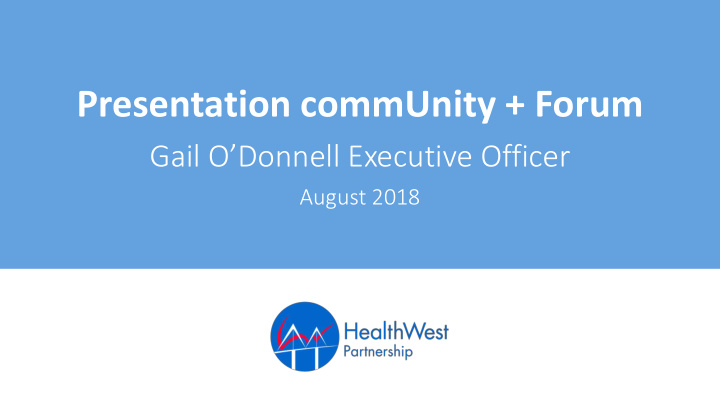



Presentation commUnity + Forum Gail O’Donnell Executive Officer August 2018
• HealthWest is the Primary Care Partnership (PCP) in Melbourne’s west • PCPs are state funded (DHHS) – 28 across Victoria • Voluntary alliance of 54 members working together to improve the health & wellbeing of communities in our catchment • PCPs act as system improvers and have been part of the Victorian health & community service system for 18 years
Systems thinking • Acknowledge we operate in a system with many parts • Look at linkages, interactions and partnership opportunities between the components. We need to: Consider the interactive nature and interdependence of external and internal factors. Involve multiple actors that can see the system from different vantage points. 3
Systems thinking, complexity and collaboration You need to get different people, from different points of view, who are seeing different parts of the system to come together and collectively start to see something that individually none of them see. http://www.mutualresponsibility.org/science/what-is-systems-thinking-peter-senge-explains-systems-thinking-approach-and-principles 4
What is the difference between collaboration and other ways of working? Collective Compet Co-exist Communicate Cooperate Coordinate Collaborate Integrate Impact e Org’s systematically Competition for Inter-agency Fully integrated clients, resources, information sharing adjust and align work programs planning, partners, public e.g. networking with each other for funding. May mean org’s merge, co attention. greater outcomes. Can mean co- locate, share location. common staff, systems etc. No systematic As needed, often Longer term Alignment of connection between informal, interaction interaction based common agenda & agencies. on discrete activities on shared mission, measures for a shared vision – or projects. goals; shared across sectors – decision-makers and resources. focused on systems change – may adopt all / some ‘Co’ or integration activities. Turf Trust 5
Why is collaboration different? • It is about using information to create something different together • Thrives on differences and requires the sparks of dissent • Established to solve problems, develop new understandings, design new products • Exists to achieve a measurable outcome rather than just an improvement in process • Ends in some common ground but they often don’t begin there Collaboration vs C-Three (Cooperation, Coordination and Communication by Leo Denise Innovating Vol 7, No 3
Collaboration theory of change: If we engage around key issues / opportunities that the community WHAT cares about in a collaborative and adaptive way HOW (i.e. our joint resources, skills and effort will be better coordinated & aligned) and we reduce and we innovate and we create duplication and fill together system level change in gaps WHY we will achieve better outcomes
Collective Impact Framework 1. Common agenda 2. Shared measurement 3. Mutually reinforcing activities 4. Continuous communication 5. Backbone Organisation 8 Kania & Kramer 2011
Backbone Organisation Guide Vision and Strategy Support Aligned Activities Establish Shared Measurement Practices Build Public Will Advance Policy Mobilise Funding Backbone support refers to independent, funded staff dedicated to stakeholder management and building collective ownership. Kania & Kramer (2011) 9
Preventing Violence Together 2030 Preventing Violence Together is a regional partnership made up of 19 organisations who work together to prevent violence against women across Melbourne’s west. The strategy will guide the work of the Preventing Violence Together partnership, by outlining actions and a shared vision: ‘women and girls across Melbourne’s west live free from violence and discrimination and have equal status, rights, opportunities, representation and respect’.
What is Workforce Mutuality? Workforce mutuality is the extent to which the 2016: HealthWest Strategic Leadership Forum identified a “diversity gap” between our diversity of an organisation or a sector’s workforce workforce and the community reflects the diversity of the community. 2017-18: Expert Advisory Panel made up of HealthWest members and peak organisations across the health, community, employment and It also describes an organisation or sector’s corporate sectors convened responsiveness to a diverse community. From July 2018: Pilot phase of Standards The concept has been developed at HealthWest Partnership as a way to reframe diversity in the workforce that is more in line with the diversity of the community.
Purpose of f the Standards 1. 1. Attractin ing, g, developin ing and retainin ing a workforce that is is more in inclu lusive and refle lective of the div iversity of the community 2. 2. Im Improvin ing the responsiv iveness of organis isations to the needs of people le from div iverse backgrounds
What can go wrong • The issue doesn’t require a collaborative approach -it could be solved by another approach • Lack of common agenda & shared understanding of the intended outcome(s) • Confused governance, implementation and evaluation structures • Agencies not working in their areas of strength and in alignment • Funding and policy environments not supporting action • Shared measurement not in place to track early effort and progress
When do you know you are kicking goals- system measures of f success 1. Funding flows i.e. changes in philanthropic, government and partners funding is aligned with the collaboration goals 2. Cultural norms i.e. social or cultural norms that govern behaviour are evolving to support the collaboration goals 3. Public policy i.e. strengthen alliances around collaboration goals, policy agenda have been adopted, policies are blocked that do not align with collaboration. 4. Professional practice i.e. professional standards are evolving, adapting and innovating to support the collaboration goals. 15
Thank you & acknowledgements
Recommend
More recommend